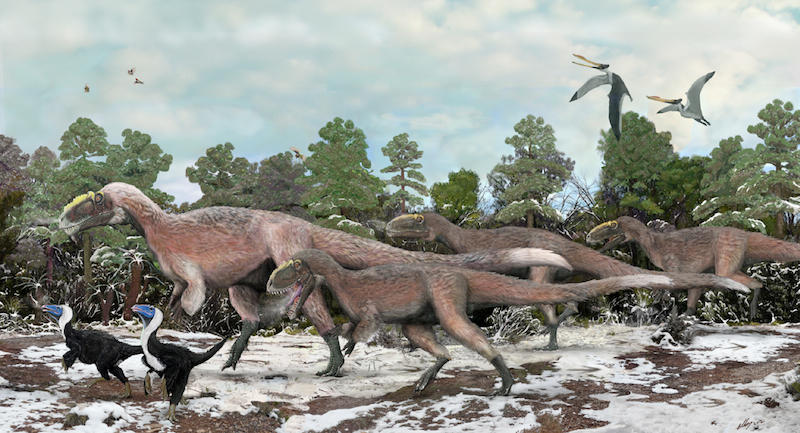Please note: Osher Rainforest will be closed for maintenance Jan. 14–16.
Science News
Beautiful Feathered Tyrant
April 5, 2012

Beautiful feathered tyrant. Great name, right? It’s the English translation of Yutyrannus huali, the Mandarin-Latin name for a new species of tyrannosaur discovered in China’s Liaoning Province.
And it’s the “feathered” part of its name that is the most significant to paleontologists. ScienceNOW explains why:
The long, filament-like feathers preserved with three relatively complete skeletons of the newly described species provide direct evidence of extensively feathered gigantic dinosaurs. The discovery is controversial—and in some scientific circles, largely unexpected.
Yutyrannus is the largest feathered animal known—30 feet long and weighing 1.5 tons. Until this discovery, feathered dinosaurs were all on the small size. The largest of these, Beipiaosaurus, is forty times smaller than Yutyrannus.
“Yutyrannus dramatically increases the size range of dinosaurs for which we have definite evidence of feathers,” says Xu Xing of Beijing's Institute of Vertebrate Paleontology and Paleoanthropology, the researcher who discovered Yutyrannus. “It's possible that feathers were much more widespread, at least among the meat-eating dinosaurs, than most scientists would have guessed even a few years ago.”
Yutyrannus is only a fifth or so the size of its distant cousin, the famous Tyrannosaurus rex, but its feathered presence is also causing some scientists to question T. rex’s coverage. While most continue to believe that T. rex was covered in scales and not plumage, Ed Yong’s blog in Discover explains that this new discovery doesn’t rule out a feathery T. rex beast.
Beyond T. rex, Yutyrannus’ feathers have scientists scratching their heads for another reason. Why does the large dino even have them?
“The feathers of Yutyrannus were simple filaments," explains Xu. "They were more like the fuzzy down of a modern baby chick than the stiff plumes of an adult bird.”
This downy structure and the large size of Yutyrannus would have made flight an impossibility, but the feathers may have had another important function—insulation.
“The idea that primitive feathers could have been for insulation rather than flight has been around for a long time,” says Corwin Sullivan, a Canadian paleontologist involved in the research. “However, large-bodied animals typically can retain heat quite easily, and actually have more of a potential problem with overheating. That makes Yutyrannus, which is large and downright shaggy, a bit of a surprise.”
The explanation may be climate-related, the researchers say. While the Cretaceous Period (the time of T. rex) was generally very warm, Yutyrannus lived during the middle part of the Early Cretaceous, when temperatures are thought to have been somewhat cooler.
The research was published this week in Nature.
Image: Dr. Brian Choo